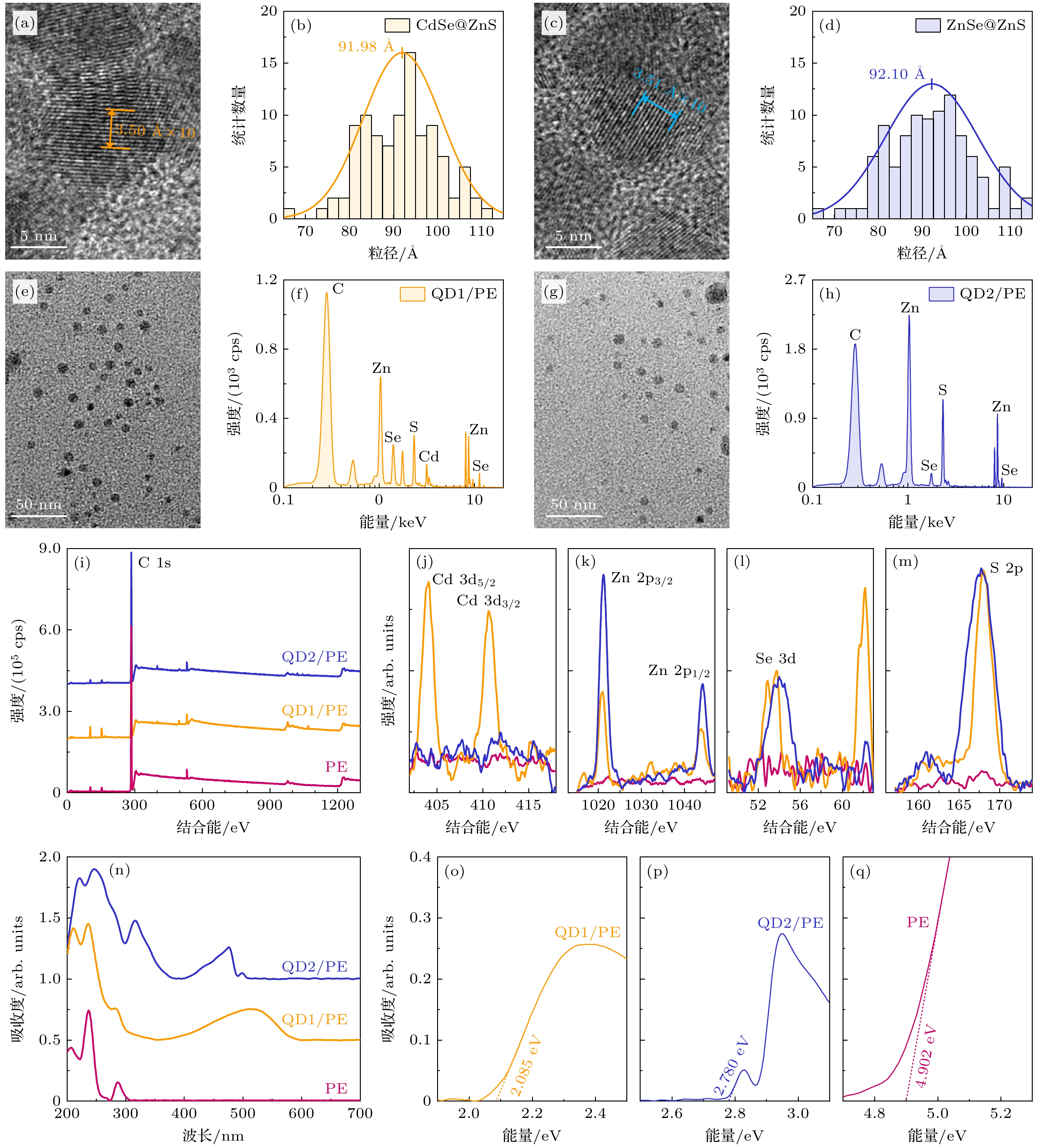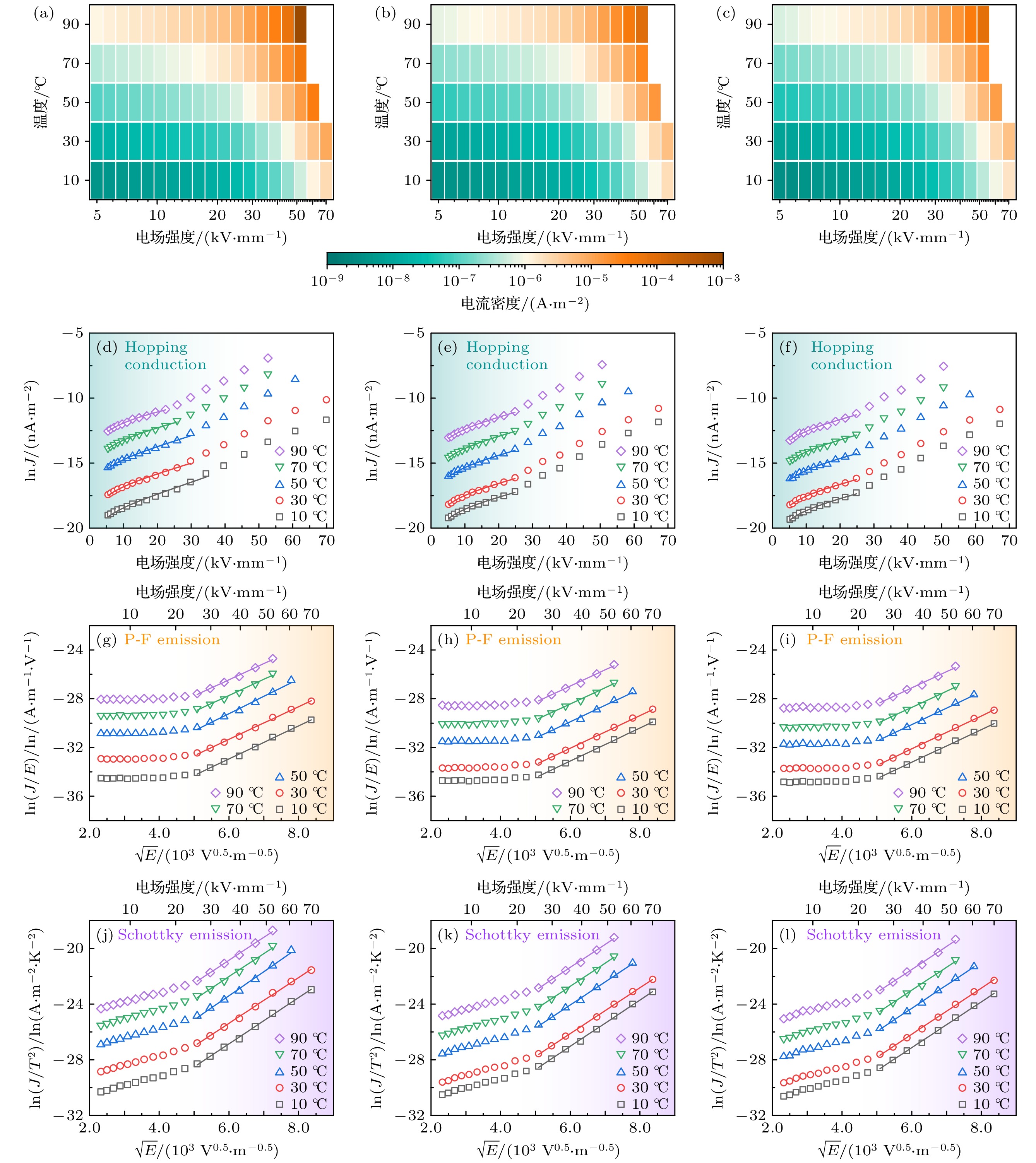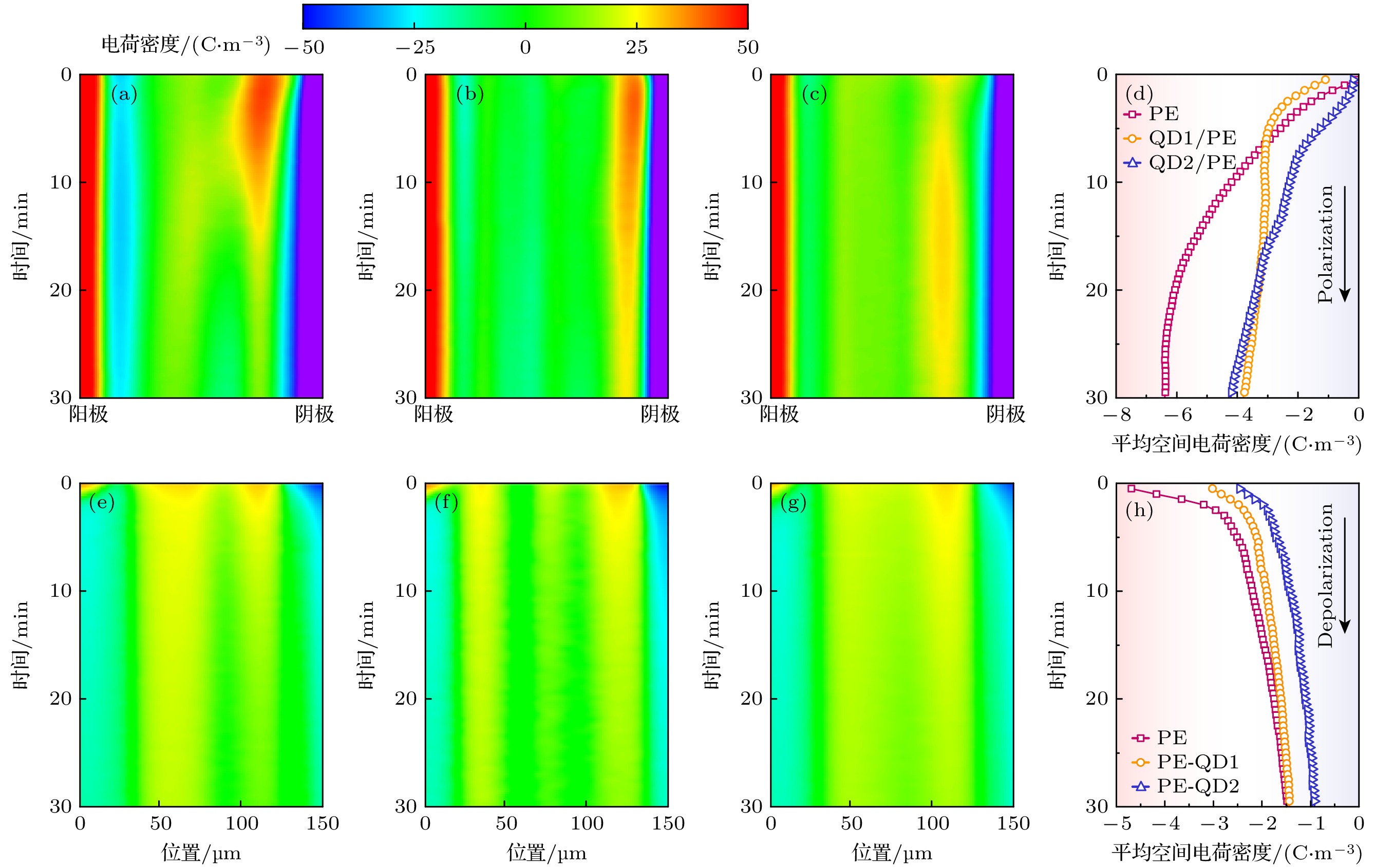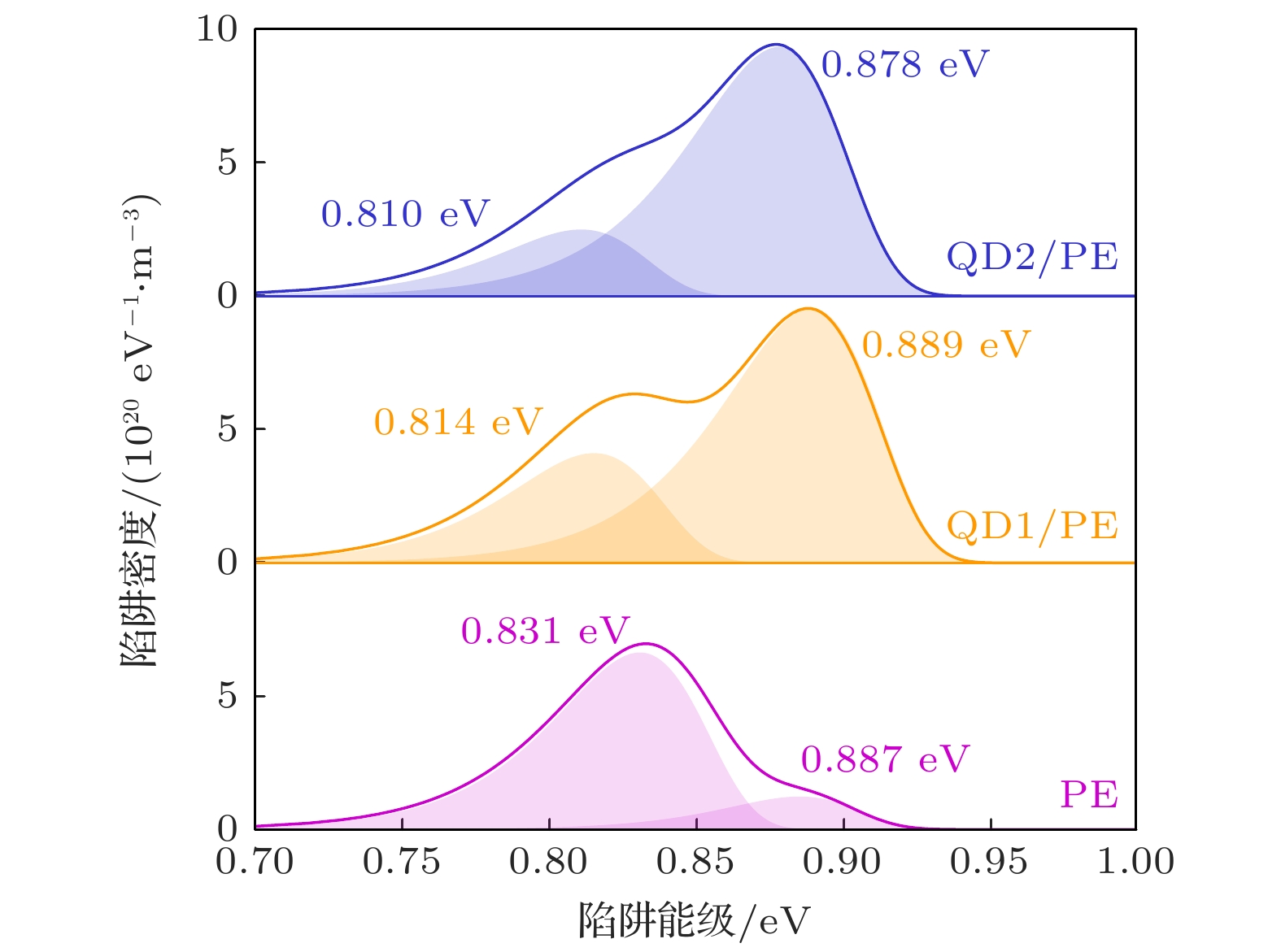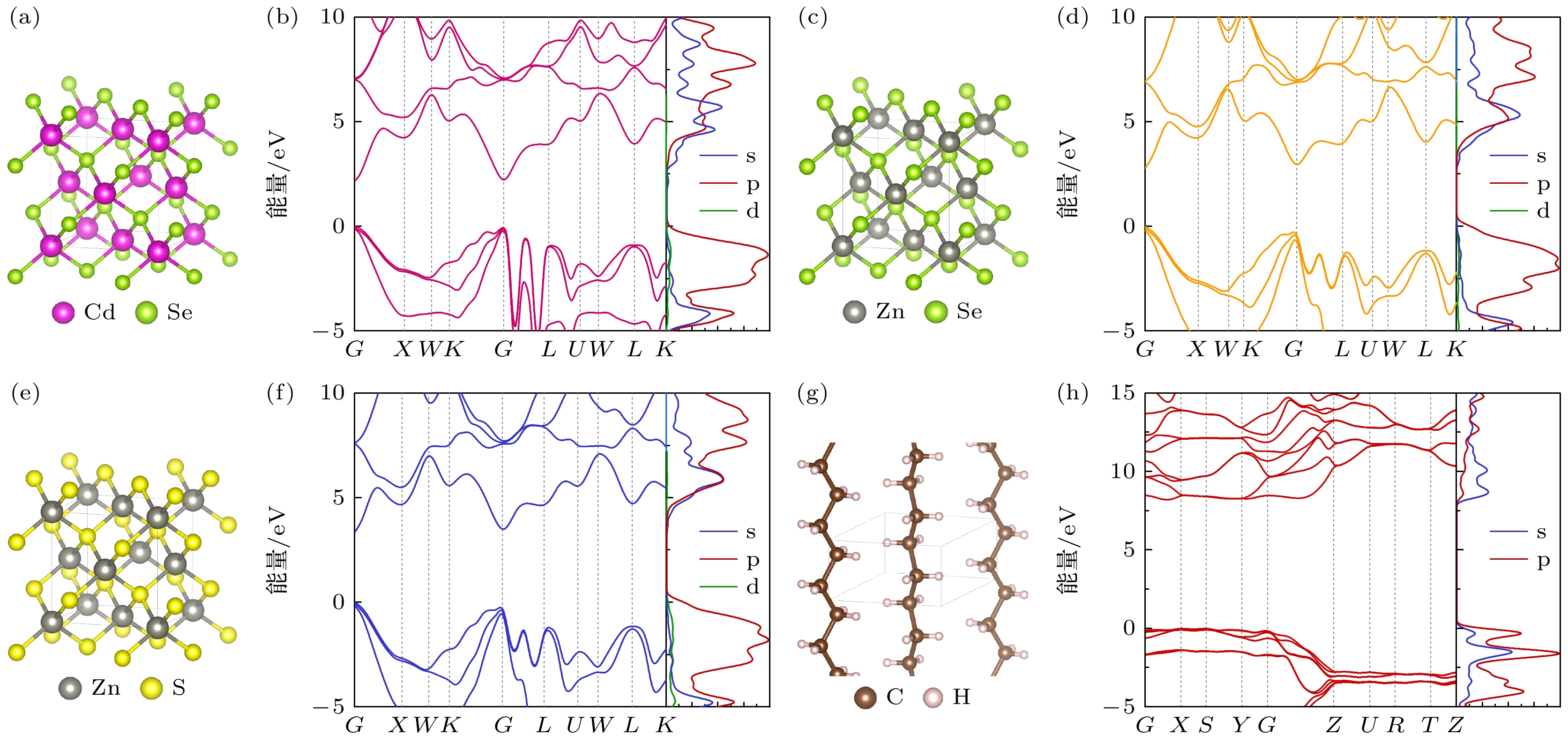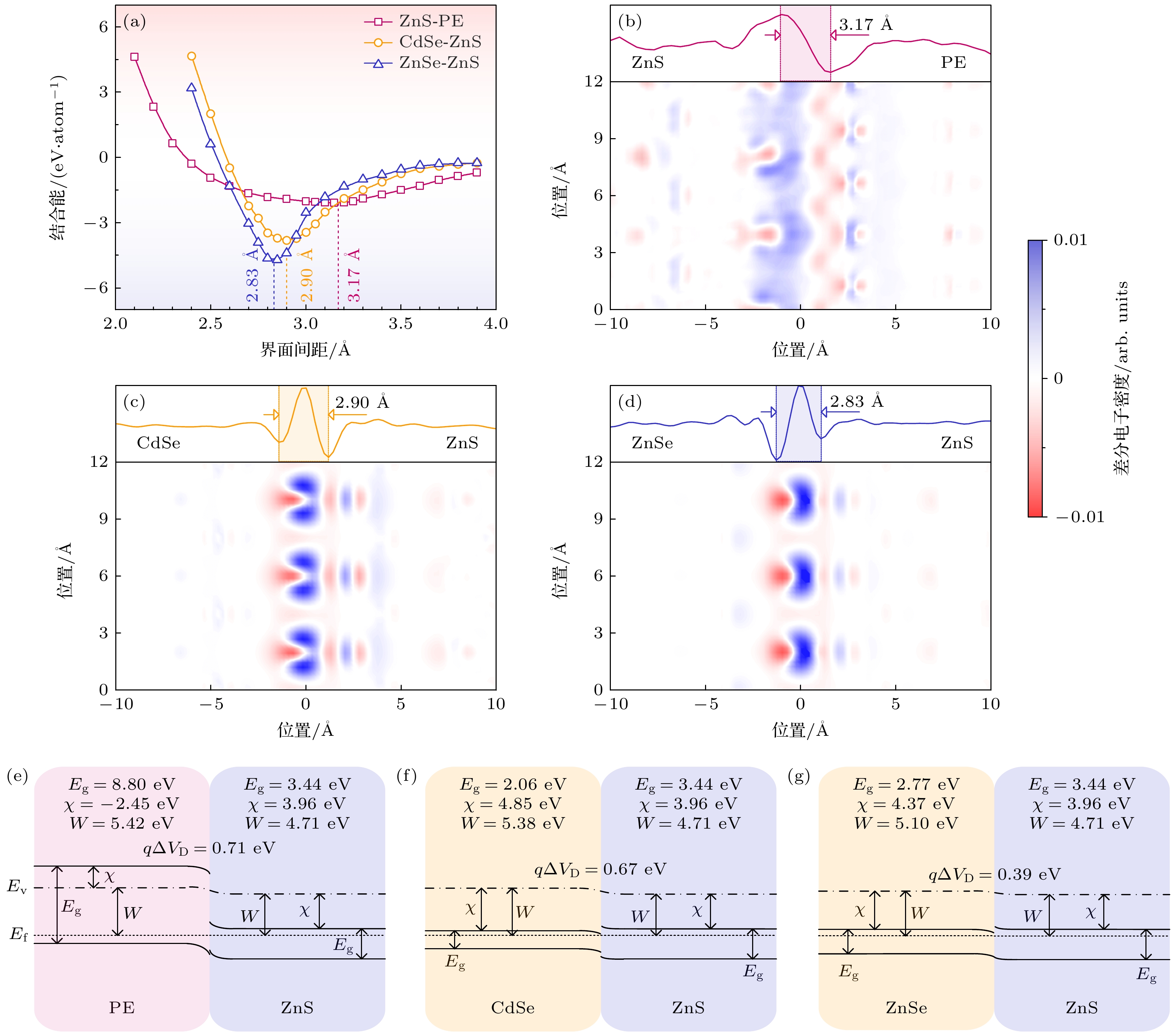-
为研究核壳量子点的界面电子结构对聚乙烯绝缘电导与空间电荷特性的影响, 分别制备了CdSe@ZnS/LDPE, ZnSe@ZnS/LDPE两种核壳量子点纳米复合绝缘, 研究了复合绝缘的直流电导和空间电荷的演变规律, 并分析了核壳量子点的界面电子结构对电荷陷阱分布特性的影响机理. 研究发现, 相比于LDPE绝缘, ZnSe@ZnS/LDPE复合绝缘在高温强场条件下直流电导率可降低47.2%, 空间电荷积累量降低了40.3%, 且陷阱能级增大, 表现出对载流子更强的捕获作用. 基于密度泛函理论, 计算了核壳量子点与聚乙烯绝缘的能带特征. 结果表明, 核壳纳米量子点的核层-壳层界面、壳层-绝缘界面的能带偏移导致导带底与价带顶发生突变, 分别对电子和空穴具有限域作用, 且限域效应随着量子点核层与壳层带隙差异增大而逐渐增强, 从而限制高温强场下载流子迁移、抑制空间电荷积聚.To investigate the effect of the interface electronic structure of core-shell quantum dots on the conductivity and space charge characteristics of polyethylene insulation, nanocomposite insulations, namely CdSe@ZnS/LDPE and ZnSe@ZnS/LDPE, are synthesized. The study focuses on elucidating the evolution patterns of DC conductivity and space charge in the nanocomposite insulation, and analyzing the effect of the interfacial electronic structure of core-shell quantum dots on the distribution of charge traps. Comparative analysis reveals that in contrast to LDPE insulation, ZnSe@ZnS/LDPE nanocomposite insulation demonstrates a substantial reduction in DC conductivity by 47.2% and a decrease in space charge accumulation by 40.3% under the conditions of elevated temperature and strong electric field. The increase of trap energy level means an enhanced trap effect on charger carriers. According to density functional theory, the band structure characteristics of core-shell quantum dots integrated with polyethylene are computationally assessed. The findings underscore that the band misalignment at the core-shell interface and the shell-insulation interface induces shifts in the conduction band bottom and at the valence band top, respectively. These shifts impose a confinement effect on electrons and holes, with the extent of this effect escalating with the augment of the difference in band gap between the core layer and the shell layer. Consequently, this phenomenon curtails carrier migration, thereby inhibiting space charge accumulation under the conditions of elevated temperature and strong electric fields.
-
Keywords:
- nanocomposite insulation /
- core-shell quantum dots /
- space charge /
- carrier migration
[1] 俞葆青, 夏兵, 杨晓砚, 万宝全, 查俊伟 2023 物理学报 72 068402
 Google Scholar
Google Scholar
Yu B Q, Xia B, Yang X Y, Wan B Q, Zha J W 2023 Acta Phys. Sin. 72 068402
 Google Scholar
Google Scholar
[2] Li Z L, Du B X 2018 IEEE Electr. Insul. Mag. 34 30
 Google Scholar
Google Scholar
[3] 杜伯学, 韩晨磊, 李进, 李忠磊 2019 电工技术学报 34 179
 Google Scholar
Google Scholar
Du B X, Han C L, Li J, Li Z L 2019 Trans. Chin. Electrotech. Soc. 34 179
 Google Scholar
Google Scholar
[4] 何金良, 党斌, 周垚, 胡军 2015 高电压技术 41 1417
 Google Scholar
Google Scholar
He J L, Dang B, Zhou Y, Hu J 2015 High Voltage Eng. 41 1417
 Google Scholar
Google Scholar
[5] Mazzanti G, Diban B 2021 IEEE Trans. Power Delivery 36 3784
 Google Scholar
Google Scholar
[6] Lewis T J 2014 IEEE Trans. Dielectr. Electr. Insul. 21 497
 Google Scholar
Google Scholar
[7] Tanaka T, Kozako M, Fuse N, Ohki Y 2005 IEEE Trans. Dielectr. Electr. Insul. 12 669
 Google Scholar
Google Scholar
[8] Takada T, Hayase Y, Tanaka Y 2008 IEEE Trans. Dielectr. Electr. Insul. 15 152
 Google Scholar
Google Scholar
[9] Zhu X, Wu J, Wang Y, Yin Y 2020 IEEE Trans. Dielectr. Electr. Insul. 27 450
 Google Scholar
Google Scholar
[10] Li S T, Zhao N, Nie Y J, Wang X, Chen G, Teyssedre G 2015 IEEE Trans. Dielectr. Electr. Insul. 22 92
 Google Scholar
Google Scholar
[11] Ye C, Zhang D S, Chen B, Tung C H, Wu L Z 2023 Chem. Phys. Rev. 4 011304
 Google Scholar
Google Scholar
[12] Han C L, Du B X, Li J, Li Z L, Tanaka T 2020 IEEE Trans. Dielectr. Electr. Insul. 27 1204
 Google Scholar
Google Scholar
[13] Yang M, Wang S, Fu J, Zhu Y, Liang J, Cheng S, Hu S, Hu J, He J, Li Q 2023 Adv. Mater. 35 2301936
 Google Scholar
Google Scholar
[14] Smith A M, Lane L A, Nie S M 2014 Nat. Commun. 5 4506
 Google Scholar
Google Scholar
[15] Tanaka T 2019 IEEE Trans. Dielectr. Electr. Insul. 26 276
 Google Scholar
Google Scholar
[16] Lei Z P, Fabiani D, Bray T, Li C Y, Wang X Y, Andritsch T, Credi A, La Rosa M 2021 IEEE Trans. Dielectr. Electr. Insul. 28 753
 Google Scholar
Google Scholar
[17] Moyassari A, Unge M, Hedenqvist M S, Gedde U W, Nilsson F 2017 J. Chem. Phys. 146 204901
 Google Scholar
Google Scholar
[18] Chen X, Zhao A X, Li J M, Deng J B, Zhang G J, Zhao X F 2019 J. Appl. Phys. 126 035101
 Google Scholar
Google Scholar
[19] Lü Z P, Ma Y T, Zhang C, Peng J Y, Wu K, Dissado L A 2021 IEEE Trans. Dielectr. Electr. Insul. 28 616
 Google Scholar
Google Scholar
[20] Simmons J G, Tam M C 1973 Phys. Rev. B 7 3706
 Google Scholar
Google Scholar
[21] Cheng S, Zhou Y, Li Y, Yuan C, Yang M, Fu J, Hu J, He J, Li Q 2021 Energy Storage Mater. 42 445
 Google Scholar
Google Scholar
[22] 董久锋, 邓星磊, 牛玉娟, 潘子钊, 汪宏 2020 物理学报 69 217701
 Google Scholar
Google Scholar
Dong J F, Deng X L, Niu Y J, Pan Z Z, Wang H 2020 Acta Phys. Sin. 69 217701
 Google Scholar
Google Scholar
[23] Emtage P R, Tantraporn W 1962 Phys. Rev. Lett. 8 267
 Google Scholar
Google Scholar
[24] Hoang A T, Pallon L, Liu D, Serdyuk Y V, Gubanski S M, Gedde U W 2016 Polymers 8 87
 Google Scholar
Google Scholar
[25] Zhou L, Wang X, Zhang Y, Zhang P, Li Z 2019 Materials 12 2657
 Google Scholar
Google Scholar
[26] Akram S, Bhutta M S, Zhou K, Meng P F, Castellon J, Wang P, Rasool G, Aamir M, Nazir M T 2021 IEEE Trans. Dielectr. Electr. Insul. 28 1514
 Google Scholar
Google Scholar
[27] Fishchuk I I, Kadashchuk A K, Vakhnin A, Korosko Y, Bässler H, Souharce B, Scherf U 2006 Phys. Rev. B 73 115210
 Google Scholar
Google Scholar
[28] Li C, Duan L, Li H, Qiu Y 2014 J. Phys. Chem. C 118 10651
 Google Scholar
Google Scholar
[29] 屠德民, 王霞, 吕泽鹏, 吴锴, 彭宗仁 2012 物理学报 61 01704
 Google Scholar
Google Scholar
Tu D M, Wang X, Lv Z P, Wu K, Peng Z R 2012 Acta Phys. Sin. 61 01704
 Google Scholar
Google Scholar
[30] 张睿智, 陈文灏, 杨璐娜 2012 物理学报 61 187201
 Google Scholar
Google Scholar
Zhang R Z, Chen W H, Yang L N 2012 Acta Phys. Sin. 61 187201
 Google Scholar
Google Scholar
[31] Hewa-Kasakarage N N, Kirsanova M, Nemchinov A, Schmall N, El-Khoury P Z, Tarnovsky A N, Zamkov M 2009 J. Am. Chem. Soc. 131 1320
 Google Scholar
Google Scholar
[32] Chen X H, Chen Y T, Ren F F, Gu S L, Tan H H, Jagadish C, Ye J D 2019 Appl. Phys. Lett. 115 202101
 Google Scholar
Google Scholar
-
图 2 核壳量子点/聚乙烯复合绝缘的理化性能表征(1 cps = 1 counts/s) (a) CdSe@ZnS量子点TEM图; (b) CdSe@ZnS量子点粒径分布; (c) ZnSe@ZnS量子点TEM图; (d) ZnSe@ZnS量子点粒径分布; (e) QD1/PE绝缘TEM图; (f) QD1/PE绝缘EDS谱图; (g) QD2/PE绝缘TEM图; (h) QD2/PE绝缘EDS谱图; (i) 核壳量子点/聚乙烯复合绝缘XPS全谱; (j)—(m) Cd, Zn, Se和S元素精细谱; (n) 核壳量子点/聚乙烯复合绝缘UV-Vis吸收谱; (o)—(q) 核壳量子点/聚乙烯复合绝缘光学带隙
Fig. 2. Characterization of physical and chemical properties of core-shell quantum dots/polyethylene composite insulation: (a) TEM of CdSe@ZnS QDs; (b) particle size distribution of CdSe@ZnS QDs; (c) TEM of ZnSe@ZnS QDs; (d) particle size distribution of ZnSe@ZnS QDs; (e) TEM of QD1/PE insulation; (f) EDS of QD1/PE insulation; (g) TEM of QD2/PE insulation; (h) EDS of QD2/PE insulation; (i) XPS full spectra of composite insulation; (j)–(m) XPS fine spectra of Cd, Zn, Se, and S; (n) UV-Vis absorption spectra of composite insulation; (o)–(q) optical gap of composite insulation.
图 3 聚乙烯绝缘和核壳量子点/聚乙烯复合绝缘的电导特性 (a)—(c) PE, QD1/PE和QD2/PE绝缘电导特性; (d)—(f) 基于跳跃电导模型的PE, QD1/PE和QD2/PE绝缘电导特性; (g)—(i) 基于P-F发射效应的PE, QD1/PE和QD2/PE绝缘电导特性; (j)—(l) 基于肖特基发射效应的PE, QD1/PE和QD2/PE绝缘电导特性
Fig. 3. Conductivity characteristics of polyethylene insulation and core-shell quantum dot/polyethylene composite insulation: (a)–(c) Current density characteristics of PE, QD1/PE and QD2/PE insulation; (d)–(f) conductivity characteristics of PE, QD1/PE and QD2/PE insulation based on hopping conductivity model; (g)–(i) conductivity characteristics of PE, QD1/PE and QD2/PE insulation based on P-F emission effect; (j)–(l) conductivity characteristics of PE, QD1/PE and QD2/PE insulation based on Schottky emission effect.
图 4 聚乙烯绝缘和核壳量子点/聚乙烯复合绝缘的空间电荷特性 (a) PE绝缘极化过程; (b) QD1/PE绝缘极化过程; (c) QD2/PE绝缘极化过程; (d) 极化过程平均空间电荷密度变化情况; (e) PE绝缘去极化过程; (f) QD1/PE绝缘去极化过程; (g) QD2/PE绝缘去极化过程; (h) 去极化过程平均空间电荷密度变化情况
Fig. 4. Space charge characteristics of polyethylene insulation and core-shell quantum dot/polyethylene composite insulation: (a) Polarization of PE insulation; (b) polarization of QD1/PE insulation; (c) polarization of QD2/PE insulation; (d) average space charge density during the polarization process; (e) depolarization process of PE insulation; (f) depolarization process of QD1/PE insulation; (g) depolarization process of QD2/PE insulation; (h) average space charge density during the depolarization process.
图 6 核壳量子点与聚乙烯绝缘的能带结构与态密度 (a) CdSe晶体模型; (b) CdSe能带结构与态密度; (c) ZnSe晶体模型; (d) ZnSe能带结构与态密度; (e) ZnS晶体模型; (f) ZnS能带结构与态密度; (g) PE晶体模型; (h) PE能带结构与态密度
Fig. 6. Band structures and density of states of core-shell quantum dots and polyethylene: (a) CdSe crystal model; (b) CdSe band structure and DOS; (c) ZnSe crystal model; (d) ZnSe band structure and DOS; (e) ZnS crystal model; (f) ZnS band structure and DOS; (g) PE crystal model; (h) PE band structure and DOS.
图 7 核壳量子点/聚乙烯绝缘的界面结合能、差分电荷密度与界面能带结构 (a) 不同界面的结合能变化情况; (b) ZnS-聚乙烯界面的差分电子密度; (c) CdSe-ZnS界面的差分电子密度; (d) ZnSe-ZnS界面的差分电子密度; (e) PE-ZnS界面能带结构; (f) CdSe-ZnS界面能带结构; (g) ZnSe-ZnS界面能带结构
Fig. 7. Binding energy, electron density difference, and band structure of interface for core-shell quantum dot/polyethylene insulation: (a) Binding energy of different interfaces; (b) electron density difference between ZnS and PE; (c) electron density difference between CdSe and ZnS; (d) electron density difference between ZnSe and ZnS; (e) band structure between PE and ZnS; (f) band structure between CdSe and ZnS; (g) band structure between ZnSe and ZnS.
表 1 核壳量子点与聚乙烯的能带结构特征
Table 1. Band characteristics of core-shell quantum dots and polyethylene.
结构 能带间隙
Eg/eV带隙类型 电子有效质量
$m_{\rm n}^*{\mathrm{ /a.u.}}$空穴有效质量
$m_{\rm p}^*{\mathrm{ /a.u.}}$电子亲和能
χ/eV功函数
W/eVCdSe 2.06 直接带隙 0.14 0.39 4.85 5.38 ZnSe 2.77 直接带隙 0.18 0.54 4.37 5.10 ZnS 3.44 直接带隙 0.24 0.55 3.96 4.71 PE 8.80 直接带隙 >10 >10 –2.45 5.42 -
[1] 俞葆青, 夏兵, 杨晓砚, 万宝全, 查俊伟 2023 物理学报 72 068402
 Google Scholar
Google Scholar
Yu B Q, Xia B, Yang X Y, Wan B Q, Zha J W 2023 Acta Phys. Sin. 72 068402
 Google Scholar
Google Scholar
[2] Li Z L, Du B X 2018 IEEE Electr. Insul. Mag. 34 30
 Google Scholar
Google Scholar
[3] 杜伯学, 韩晨磊, 李进, 李忠磊 2019 电工技术学报 34 179
 Google Scholar
Google Scholar
Du B X, Han C L, Li J, Li Z L 2019 Trans. Chin. Electrotech. Soc. 34 179
 Google Scholar
Google Scholar
[4] 何金良, 党斌, 周垚, 胡军 2015 高电压技术 41 1417
 Google Scholar
Google Scholar
He J L, Dang B, Zhou Y, Hu J 2015 High Voltage Eng. 41 1417
 Google Scholar
Google Scholar
[5] Mazzanti G, Diban B 2021 IEEE Trans. Power Delivery 36 3784
 Google Scholar
Google Scholar
[6] Lewis T J 2014 IEEE Trans. Dielectr. Electr. Insul. 21 497
 Google Scholar
Google Scholar
[7] Tanaka T, Kozako M, Fuse N, Ohki Y 2005 IEEE Trans. Dielectr. Electr. Insul. 12 669
 Google Scholar
Google Scholar
[8] Takada T, Hayase Y, Tanaka Y 2008 IEEE Trans. Dielectr. Electr. Insul. 15 152
 Google Scholar
Google Scholar
[9] Zhu X, Wu J, Wang Y, Yin Y 2020 IEEE Trans. Dielectr. Electr. Insul. 27 450
 Google Scholar
Google Scholar
[10] Li S T, Zhao N, Nie Y J, Wang X, Chen G, Teyssedre G 2015 IEEE Trans. Dielectr. Electr. Insul. 22 92
 Google Scholar
Google Scholar
[11] Ye C, Zhang D S, Chen B, Tung C H, Wu L Z 2023 Chem. Phys. Rev. 4 011304
 Google Scholar
Google Scholar
[12] Han C L, Du B X, Li J, Li Z L, Tanaka T 2020 IEEE Trans. Dielectr. Electr. Insul. 27 1204
 Google Scholar
Google Scholar
[13] Yang M, Wang S, Fu J, Zhu Y, Liang J, Cheng S, Hu S, Hu J, He J, Li Q 2023 Adv. Mater. 35 2301936
 Google Scholar
Google Scholar
[14] Smith A M, Lane L A, Nie S M 2014 Nat. Commun. 5 4506
 Google Scholar
Google Scholar
[15] Tanaka T 2019 IEEE Trans. Dielectr. Electr. Insul. 26 276
 Google Scholar
Google Scholar
[16] Lei Z P, Fabiani D, Bray T, Li C Y, Wang X Y, Andritsch T, Credi A, La Rosa M 2021 IEEE Trans. Dielectr. Electr. Insul. 28 753
 Google Scholar
Google Scholar
[17] Moyassari A, Unge M, Hedenqvist M S, Gedde U W, Nilsson F 2017 J. Chem. Phys. 146 204901
 Google Scholar
Google Scholar
[18] Chen X, Zhao A X, Li J M, Deng J B, Zhang G J, Zhao X F 2019 J. Appl. Phys. 126 035101
 Google Scholar
Google Scholar
[19] Lü Z P, Ma Y T, Zhang C, Peng J Y, Wu K, Dissado L A 2021 IEEE Trans. Dielectr. Electr. Insul. 28 616
 Google Scholar
Google Scholar
[20] Simmons J G, Tam M C 1973 Phys. Rev. B 7 3706
 Google Scholar
Google Scholar
[21] Cheng S, Zhou Y, Li Y, Yuan C, Yang M, Fu J, Hu J, He J, Li Q 2021 Energy Storage Mater. 42 445
 Google Scholar
Google Scholar
[22] 董久锋, 邓星磊, 牛玉娟, 潘子钊, 汪宏 2020 物理学报 69 217701
 Google Scholar
Google Scholar
Dong J F, Deng X L, Niu Y J, Pan Z Z, Wang H 2020 Acta Phys. Sin. 69 217701
 Google Scholar
Google Scholar
[23] Emtage P R, Tantraporn W 1962 Phys. Rev. Lett. 8 267
 Google Scholar
Google Scholar
[24] Hoang A T, Pallon L, Liu D, Serdyuk Y V, Gubanski S M, Gedde U W 2016 Polymers 8 87
 Google Scholar
Google Scholar
[25] Zhou L, Wang X, Zhang Y, Zhang P, Li Z 2019 Materials 12 2657
 Google Scholar
Google Scholar
[26] Akram S, Bhutta M S, Zhou K, Meng P F, Castellon J, Wang P, Rasool G, Aamir M, Nazir M T 2021 IEEE Trans. Dielectr. Electr. Insul. 28 1514
 Google Scholar
Google Scholar
[27] Fishchuk I I, Kadashchuk A K, Vakhnin A, Korosko Y, Bässler H, Souharce B, Scherf U 2006 Phys. Rev. B 73 115210
 Google Scholar
Google Scholar
[28] Li C, Duan L, Li H, Qiu Y 2014 J. Phys. Chem. C 118 10651
 Google Scholar
Google Scholar
[29] 屠德民, 王霞, 吕泽鹏, 吴锴, 彭宗仁 2012 物理学报 61 01704
 Google Scholar
Google Scholar
Tu D M, Wang X, Lv Z P, Wu K, Peng Z R 2012 Acta Phys. Sin. 61 01704
 Google Scholar
Google Scholar
[30] 张睿智, 陈文灏, 杨璐娜 2012 物理学报 61 187201
 Google Scholar
Google Scholar
Zhang R Z, Chen W H, Yang L N 2012 Acta Phys. Sin. 61 187201
 Google Scholar
Google Scholar
[31] Hewa-Kasakarage N N, Kirsanova M, Nemchinov A, Schmall N, El-Khoury P Z, Tarnovsky A N, Zamkov M 2009 J. Am. Chem. Soc. 131 1320
 Google Scholar
Google Scholar
[32] Chen X H, Chen Y T, Ren F F, Gu S L, Tan H H, Jagadish C, Ye J D 2019 Appl. Phys. Lett. 115 202101
 Google Scholar
Google Scholar
计量
- 文章访问数: 4963
- PDF下载量: 108
- 被引次数: 0














 下载:
下载:
